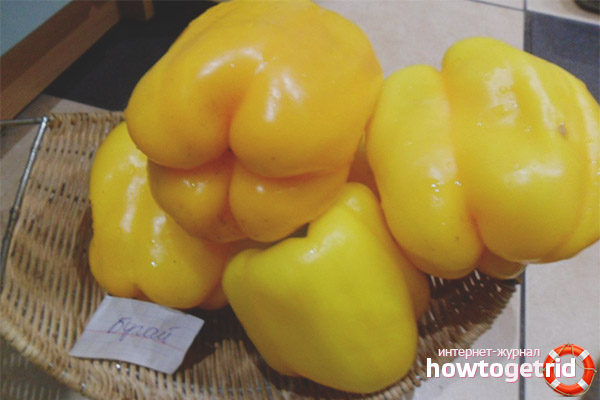The content of the article
Bugai bell peppers are rich in vitamins and trace elements necessary for normal functioning of the body. It contains a large amount of vitamin C, iron, aluminum. It is widely used in cooking in fresh or canned form, as well as after heat treatment.
Grade description
This pepper got its name because of its large impressive size, its length reaches 17 cm. The weight of one fruit varies from 200 to 300 grams. The shape of the vegetable is cuboid, slightly elongated in length. The inside of the pepper is hollow, with many seeds. The wall thickness of the fetus is 8 mm, which gives it an extraordinary juiciness. The color is often bright yellow, sunny.
Main characteristics:
- Belongs to mid-season grade.
- It has a high level of productivity, with 1 sq. Km. m. you can collect fruits with a total weight of up to 5.5 kg.
- Suitable for growing on greenhouse-type sites and in open ground.
- One bush of a plant can tie up to 12 pieces of fruit.
- The planting and cultivation period is from May to September.
- The leaves of the plant are simple, green or slightly green in color, have increased fragility. This should be considered when harvesting, so as not to damage them. The stalk is straight.
Crop cultivation technology
A bugai does not tolerate temperature changes. It is preferable to grow it in greenhouses, in open areas - only in regions with a warm climate or under conditions of sheeting.
The process of cultivating Bugai pepper consists of two main stages:
- sowing seeds;
- transplanting seedlings.
Prior to sowing the seeds, they are soaked in a weak solution of manganese. This will disinfect them, increase resistance to fungal diseases. Sowing is carried out in late February - early March. To reduce the number of transplants, seeds are sown in separate cups filled with moist soil. Sown seeds are covered with a film, which is removed only after the appearance of the first seedlings.
Seedling care includes ensuring and observing the basic conditions for its growth:
- systematic watering with warm, settled water;
- draft protection;
- providing additional sources of light;
- maintaining the necessary humidity.
Before planting seedlings in places of its constant cultivation, young plants need to be tempered, taking them out for a while on warm days. Characteristic is the stunting of seedlings after transplanting. This happens for a while, while the plant adapts to new conditions. After a certain time, pepper growth will resume with renewed vigor.
Care
Young pepper shoots planted in the soil require care for them, which will ensure a rich harvest of beautiful strong vegetables.
- The main procedures necessary for carrying out during the growth period of a vegetable crop:
- Tying up. The fruits of the plant are large and pull the stem down. The plant bends to the ground from its own weight and falls, the fruits run the risk of deterioration.
- Abundant watering with infused water.
- Providing good lighting.
- Treatment. It is carried out with a disease of the plant, an attack of pests.
- Fertilizer soil. It is carried out at the discretion of the owner of the site.
Diseases and Pests
The plant is susceptible to verticillosis, which has three different forms of disease development. If a disease occurs, pepper begins to fade and may die.For treatment, special chemical mixtures are used, fertilizing from wood ash is added, fertilizers with phosphate can be used.
The most common pests that select this variety of pepper are aphids and ticks. Insecticides are used to remove aphids. To combat the tick, the plant is sprayed with a prepared solution of liquid soap with the addition of dandelion, garlic and onion flowers.
The fruits themselves are a favorite place for slugs to appear. The fight against them is the use of tobacco dust and lime.
Fruit storage
The best way to store fruits is to freeze them in sliced form and placed in plastic bags. In this form, pepper is stored throughout the winter period.
Well pepper is subject to canning and pickling for the future. It is not suitable for preparing candied fruits or drying to obtain paprika.
Video: growing pepper from A to Z










Submit